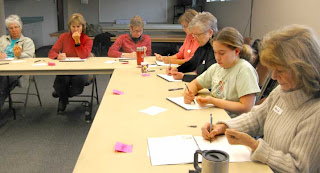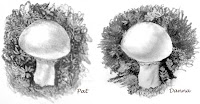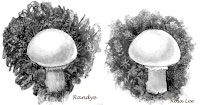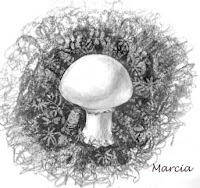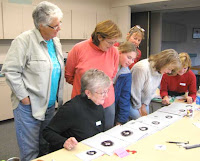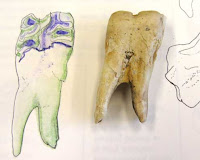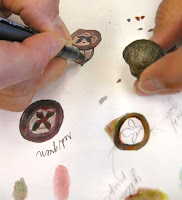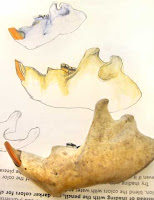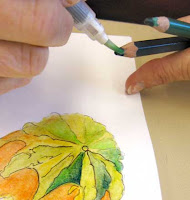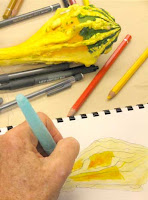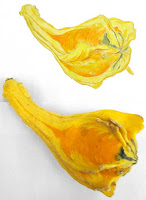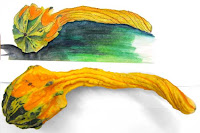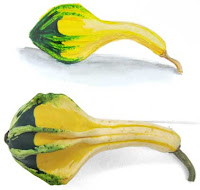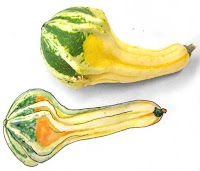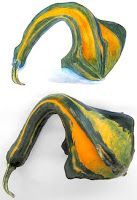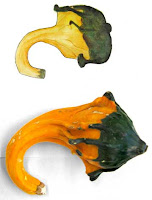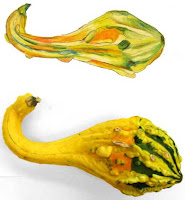 been up to my nostrils in preparing my latest sketch journal tutorial, but I wanted to surface for a minute to say hi, that I'm really still here, not disappeared down Alice's rabbit hole.
been up to my nostrils in preparing my latest sketch journal tutorial, but I wanted to surface for a minute to say hi, that I'm really still here, not disappeared down Alice's rabbit hole.The weather has finally changed from long, cold, rainy, snitty spring
 (record cold temperatures and record rainfall, BOTH) to a still fairly cool but sunny summer. The vetch is out on the hillsides in glorious profusion (see above right). The bigleaf maples (at left) have just finished flowering (did you know some people pick these flower clumps and fry them in batter like fritters? I haven't tried that yet...)
(record cold temperatures and record rainfall, BOTH) to a still fairly cool but sunny summer. The vetch is out on the hillsides in glorious profusion (see above right). The bigleaf maples (at left) have just finished flowering (did you know some people pick these flower clumps and fry them in batter like fritters? I haven't tried that yet...)Temperatures haven't even hit 90 yet, but that
 makes it great when I go down to Plant Oregon, Dan's native plant nursery, to weed every afternoon at 4 or 5pm. While the sun is still hot and the temperature varies between 60 and 80+, I weed in the shady spots, or alternate with sunny rows to warm up again. Then when the sun goes behind the western row of trees along the creek, I carry my weeding stool over to the once-sunny rows to weed. Birds are singing, bees are buzzing, it's nice.
makes it great when I go down to Plant Oregon, Dan's native plant nursery, to weed every afternoon at 4 or 5pm. While the sun is still hot and the temperature varies between 60 and 80+, I weed in the shady spots, or alternate with sunny rows to warm up again. Then when the sun goes behind the western row of trees along the creek, I carry my weeding stool over to the once-sunny rows to weed. Birds are singing, bees are buzzing, it's nice.But
 in the mornings I am at my computer, sorting out which photos (of some 730 of them) to use in the tutorial, which means I'm reliving my vacation in Kauai again, day by day, beach-crawl by beach-crawl, satisfying day by day. I'll experience the whole thing again when I put it together and write the tutorial. And then every time I pull the original journal down off the shelf to read it. How could you top that?!
in the mornings I am at my computer, sorting out which photos (of some 730 of them) to use in the tutorial, which means I'm reliving my vacation in Kauai again, day by day, beach-crawl by beach-crawl, satisfying day by day. I'll experience the whole thing again when I put it together and write the tutorial. And then every time I pull the original journal down off the shelf to read it. How could you top that?!But ya sure wouldn't want to do a tutorial for a BAD trip! Ouch!
Anyway, I thought you might be interested in how it's coming along, although I haven't yet started writing the tutorials.

For the Sea Biscuit tutorial page, I wanted to set the scene with what the beach morning glory vine looked like as I sat sketching. Here are the two photos I'll use for that, plus one I found later in bloom. It's a gorgeous, lush plant, growing on a hot sandy beach you wouldn't think could support such luxuriant growth.



The "sea biscuit" is so exquisite I spent about two hours drawing it.
 I was so entranced and sat so long my bum got numb. If you look at it close up, you'll see lots of little raised white dots. There was probably a spine attached to each one. I wonder if this is the remains of the spiny black sea urchin I saw earlier washed up onshore.....I don't have a good guide for sea urchin tests (a test is this calcareous skeleton left behind when the animal goes to meet its maker).
I was so entranced and sat so long my bum got numb. If you look at it close up, you'll see lots of little raised white dots. There was probably a spine attached to each one. I wonder if this is the remains of the spiny black sea urchin I saw earlier washed up onshore.....I don't have a good guide for sea urchin tests (a test is this calcareous skeleton left behind when the animal goes to meet its maker).Then
 , since I journaled about the yummy mango that washed up on shore and ended up in my tummy (most of it) and Daniel's (the ridiculously small amount I could bear to be a generous person and share...), I'll include a photo of that, too. The crabs had eaten part of it, the pigs. Best mango I ever tasted!
, since I journaled about the yummy mango that washed up on shore and ended up in my tummy (most of it) and Daniel's (the ridiculously small amount I could bear to be a generous person and share...), I'll include a photo of that, too. The crabs had eaten part of it, the pigs. Best mango I ever tasted!This will all be accompanied with a discussion of how I approached the page, dealt with setbacks, worked out the symmetry of the test, and did the decorative Hawaiian style border on the right side of the page.
Another page, with brilliant red African Tulip Tree blossoms, posed entirely different challenges.

The
 original view from the window was too far away for drawing with any clarity, so I worked partially from a photo. Working from the screen of a digital camera allows you to magnify detail a lot, but even so, the details of that flower cluster were ambiguous, so I had to examine a fallen bloom
original view from the window was too far away for drawing with any clarity, so I worked partially from a photo. Working from the screen of a digital camera allows you to magnify detail a lot, but even so, the details of that flower cluster were ambiguous, so I had to examine a fallen bloom  from a different tree to see how the flowers were constructed.
from a different tree to see how the flowers were constructed.The tutorial will discuss the possible pitfalls of working from photos, and also how to get strong, vibrant color with watercolor pencils ~ which many artists have avoided because they thought it couldn't be accomplished. It can be, as you can see.
So I'm working busily away in my studio looking out into the oh-so-green woods. That rainy spring may have been depressing, but it engendered some of the most riotous greens I've ever seen. The very air is tinted green, even in my studio!
I'm almost finished sorting through the photos in Photoshop, correcting the lighting, making dull, cloudy day pictures sparkle (yes, we had several cloudy days, and those pictures look a LOT better if
 I brighten them up a bit), and rescuing underexposed photos (hey, check out the before-and-after photo here ~ there's a lot of information you can rescue if you know how to find it, although some of it, color mostly, is lost). It's fun, and I love it.
I brighten them up a bit), and rescuing underexposed photos (hey, check out the before-and-after photo here ~ there's a lot of information you can rescue if you know how to find it, although some of it, color mostly, is lost). It's fun, and I love it.I'll be done preparing in a couple of days, then I'll start assembling everything into the book in InDesign, the Adobe desktop publishing program I use for all my books, and you'll be able to download it in a month or so, I hope.
If you have put your name in the little bitty box near the end of the right column above, you'll be notified when I blog about uploading it so you can get your copy.
Until then, Aloha! And have a good summer!






